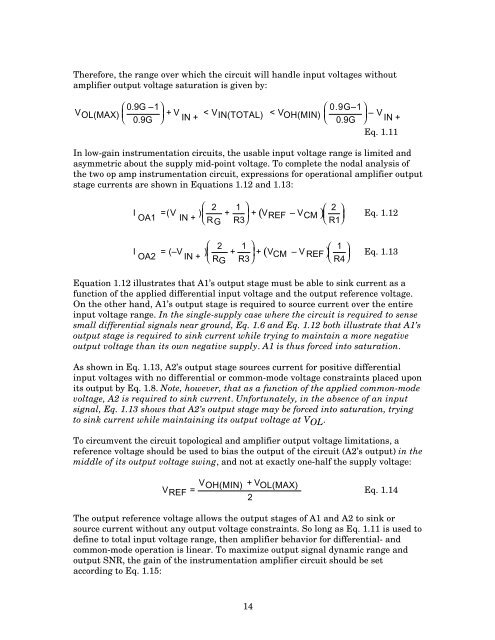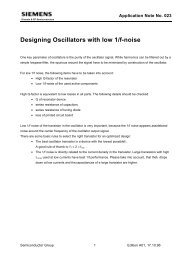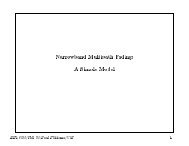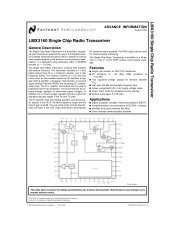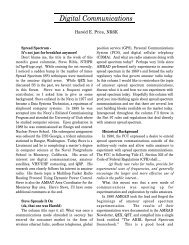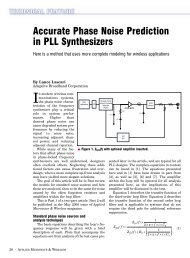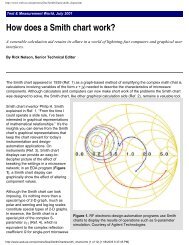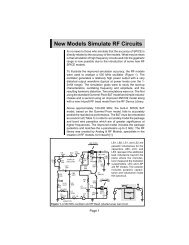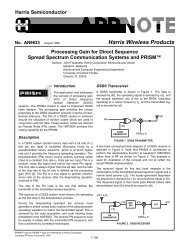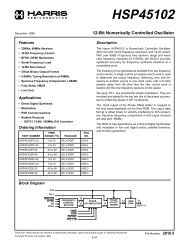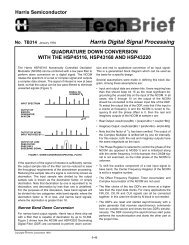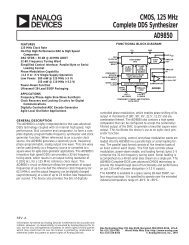SECTION 1 SINGLE-SUPPLY AMPLIFIERS - Analog Devices
SECTION 1 SINGLE-SUPPLY AMPLIFIERS - Analog Devices
SECTION 1 SINGLE-SUPPLY AMPLIFIERS - Analog Devices
- No tags were found...
You also want an ePaper? Increase the reach of your titles
YUMPU automatically turns print PDFs into web optimized ePapers that Google loves.
Therefore, the range over which the circuit will handle input voltages withoutamplifier output voltage saturation is given by:⎛ 0.9G –1⎞⎛ 0.9G–1⎞V OL(MAX) ⎜ ⎟ + V < V0.9G IN + IN(TOTAL) < V⎝OH(MIN) ⎜ ⎟⎠⎝ 0.9G ⎠– V IN +Eq. 1.11In low-gain instrumentation circuits, the usable input voltage range is limited andasymmetric about the supply mid-point voltage. To complete the nodal analysis ofthe two op amp instrumentation circuit, expressions for operational amplifier outputstage currents are shown in Equations 1.12 and 1.13:( )2I =(V ) ⎛ OA1 IN + RG + 1 R3 + V REF – V CM⎝ ⎜ ⎞⎟⎠⎛⎜⎝2 ⎞⎟ Eq. 1.12R1⎠( ) ⎜2I = (–V ) ⎛ OA2 IN + RG + 1R3 + V CM – V REF⎝ ⎜ ⎞⎟⎠⎛ 1 ⎞⎟ Eq. 1.13⎝ R4⎠Equation 1.12 illustrates that A1’s output stage must be able to sink current as afunction of the applied differential input voltage and the output reference voltage.On the other hand, A1’s output stage is required to source current over the entireinput voltage range. In the single-supply case where the circuit is required to sensesmall differential signals near ground, Eq. 1.6 and Eq. 1.12 both illustrate that A1’soutput stage is required to sink current while trying to maintain a more negativeoutput voltage than its own negative supply. A1 is thus forced into saturation.As shown in Eq. 1.13, A2’s output stage sources current for positive differentialinput voltages with no differential or common-mode voltage constraints placed uponits output by Eq. 1.8. Note, however, that as a function of the applied common-modevoltage, A2 is required to sink current. Unfortunately, in the absence of an inputsignal, Eq. 1.13 shows that A2’s output stage may be forced into saturation, tryingto sink current while maintaining its output voltage at V OL .To circumvent the circuit topological and amplifier output voltage limitations, areference voltage should be used to bias the output of the circuit (A2’s output) in themiddle of its output voltage swing, and not at exactly one-half the supply voltage:V REF = V OH(MIN) + V OL(MAX)2Eq. 1.14The output reference voltage allows the output stages of A1 and A2 to sink orsource current without any output voltage constraints. So long as Eq. 1.11 is used todefine to total input voltage range, then amplifier behavior for differential- andcommon-mode operation is linear. To maximize output signal dynamic range andoutput SNR, the gain of the instrumentation amplifier circuit should be setaccording to Eq. 1.15:14


